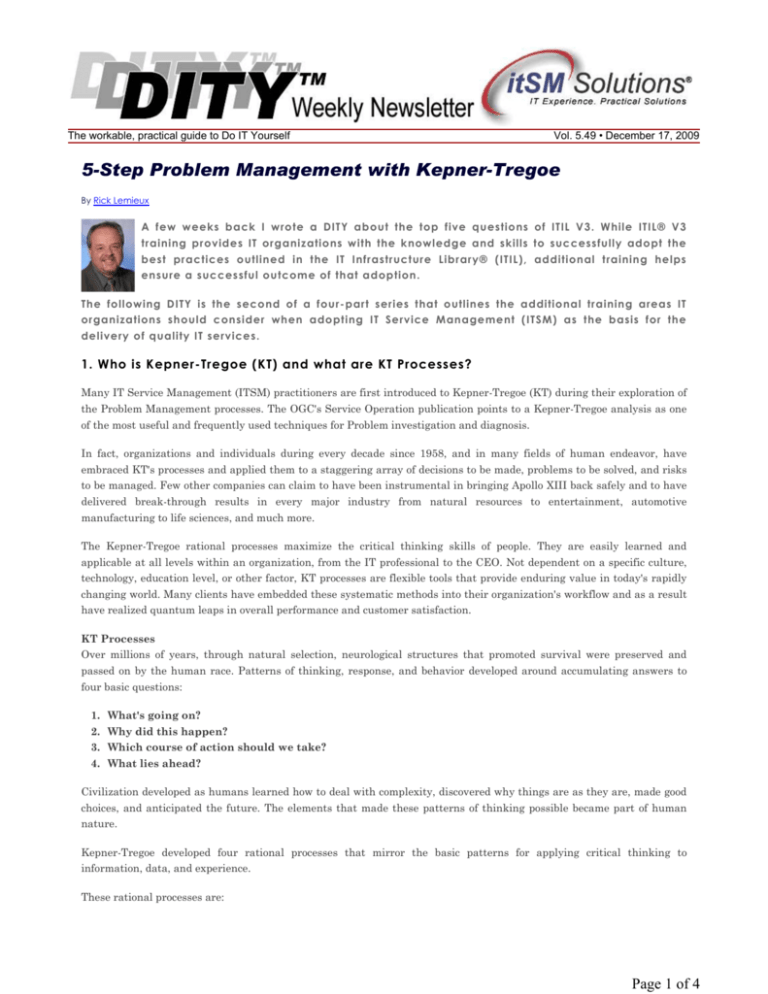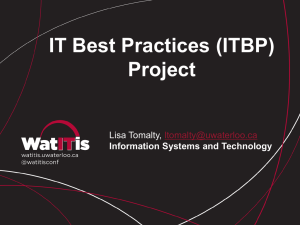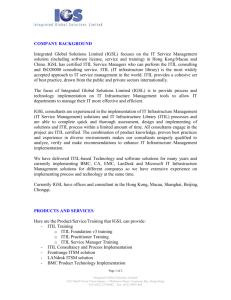
The workable, practical guide to Do IT Yourself
Vol. 5.49 • December 17, 2009
5-Step Problem Management with Kepner-Tregoe
By Rick Lemieux
A few weeks back I wrote a DITY about the top five questions of ITIL V3. While ITIL® V3
training provides IT organizations with the knowledge and skills to successfully adopt the
best practices outlined in the IT Infrastructure Library® (ITIL), additional training helps
ensure a successful outcome of that adoption.
The following DITY is the second of a four-part series that outlines the additional training areas IT
organizations should consider when adopting IT Service Management (ITSM) as the basis for the
delivery of quality IT services.
1. Who is Kepner-Tregoe (KT) and what are KT Processes?
Many IT Service Management (ITSM) practitioners are first introduced to Kepner-Tregoe (KT) during their exploration of
the Problem Management processes. The OGC's Service Operation publication points to a Kepner-Tregoe analysis as one
of the most useful and frequently used techniques for Problem investigation and diagnosis.
In fact, organizations and individuals during every decade since 1958, and in many fields of human endeavor, have
embraced KT's processes and applied them to a staggering array of decisions to be made, problems to be solved, and risks
to be managed. Few other companies can claim to have been instrumental in bringing Apollo XIII back safely and to have
delivered break-through results in every major industry from natural resources to entertainment, automotive
manufacturing to life sciences, and much more.
The Kepner-Tregoe rational processes maximize the critical thinking skills of people. They are easily learned and
applicable at all levels within an organization, from the IT professional to the CEO. Not dependent on a specific culture,
technology, education level, or other factor, KT processes are flexible tools that provide enduring value in today's rapidly
changing world. Many clients have embedded these systematic methods into their organization's workflow and as a result
have realized quantum leaps in overall performance and customer satisfaction.
KT Processes
Over millions of years, through natural selection, neurological structures that promoted survival were preserved and
passed on by the human race. Patterns of thinking, response, and behavior developed around accumulating answers to
four basic questions:
1. What's going on?
2. Why did this happen?
3. Which course of action should we take?
4. What lies ahead?
Civilization developed as humans learned how to deal with complexity, discovered why things are as they are, made good
choices, and anticipated the future. The elements that made these patterns of thinking possible became part of human
nature.
Kepner-Tregoe developed four rational processes that mirror the basic patterns for applying critical thinking to
information, data, and experience.
These rational processes are:
Page 1 of 4
Thinking Pattern
Rational Process
Assessing and Clarifying:
What's going on?
Situation Appraisal
Relating Cause and Effect:
Why did this happen?
Problem Analysis
Making Choices:
Which course of action should we take?
Decision Analysis
Anticipating the Future:
What lies ahead?
Potential Problem (Opportunity) Analysis
Kepner-Tregoe processes are universally applicable, regardless of cultural setting or content. Whether people are
Japanese, Canadian, or Brazilian, all are equipped - as a result of common human experiences - with identical,
unchangeable patterns of thinking.
In an organizational setting, rational processes can make full use of the thinking ability within the organization, on a
continuing basis. Rational processes provide organized ways of applying critical thinking skills to an issue. They
constitute an explicit, logical system that can have a far-reaching impact.
The objective is to move an organization closer to its full potential to meet critical business objectives. This is achieved by
the continuing, conscious use of common approaches, expressed in a simple language, and directed toward resolution of an
organization's important concerns.
2. Which KT training and certifications should an ITSM organization pursue?
Kepner-Tregoe training and certification programs provide IT Professionals with the knowledge and skills to effectively
manage the critical thinking process that will be used when developing anything from the ITSM Service Strategy to that
of a more effective Service Operation organization.
Having members of your IT organization trained and certified in Kepner-Tregoe methods will dramatically increase your
chances of ITSM success. Classes include:
Situation Appraisal - This program trains the IT Professional on how to clarify issues, set priority and plan
appropriate resolutions.
Problem Analysis - This program trains the IT Professional on how to find the cause of a positive or negative
deviation.
Decision Analysis - This program trains the IT Professional on how to maximize benefits and minimize risks,
yielding durable, supported decisions.
Potential Problem/Opportunity Analysis - This program trains the IT Professional on how to protect plans and
exceed expectations.
PIM (Problem & Incident Management) Certification - During this workshop, students will learn the topics in
preparation prepare you for the ISEB Certification Examination in Kepner-Tregoe ITSM Foundation Certificate in
Problem & Incident Management.
KT Rational Process Mastery - During this workshop, the IT Professional deepens his/her understanding of the
concepts of Situation Appraisal, Problem Analysis, Decision Analysis, and Potential Problem/Opportunity Analysis.
KT Analytical Trouble Shooting - During this workshop, the IT Professional deepens his/her understanding of
how Analytic Trouble Shooting® (ATSSM) integrates quality and productivity efforts, and provides a logical
framework for statistical process control, lean manufacturing, Six Sigma, total productive maintenance, selfmanaged work teams, and other programs.
3. What options are available for students to take the KT certification exams?
The PIM certification does require students to attend a class to sit for the exam at any Prometric or VUE testing center.
4. Which project management training programs will enable the ITSM Practitioner to
bring more value to an ITSM program?
The following outlines the Roles & Responsibilities an individual can assume in an IT organization once he or she
successfully completes the KT program listed for that role.
Page 2 of 4
ITIL Executive Leadership
Role
IT Executive Leadership Team
Recommended KT Training
Risk Management
ITIL V3 Service Operations Team
Role
Recommended KT Training
ITIL Service Desk Specialist
Situation Appraisal
ITIL Problem Management Specialist
Problem Analysis
ITIL Service Desk Practice Manager
Situation Appraisal
Problem Analysis
Decision Analysis
Potential Problem & Opportunity Analysis
ITIL Problem Management Practice Manager
Situation Appraisal
Problem Analysis
Decision Analysis
Potential Problem & Opportunity Analysis
ITIL Service Operation Practice Manager
Situation Appraisal
Problem Analysis
Decision Analysis
Potential Problem & Opportunity Analysis
ITIL Service Transition Team
Role
Recommended KT Training
ITIL Change Management Specialist
Decision Analysis
Potential Problem & Opportunity Analysis
ITIL Release & Deployment Management Specialist
Decision Analysis
Potential Problem & Opportunity Analysis
ITIL Transition Management Practice Manager
Decision Analysis
Potential Problem & Opportunity Analysis
ITIL Service Design Team
Role
Recommended KT Training
ITIL Service Capacity & Continuity Specialist
Decision Analysis
Potential Problem & Opportunity Analysis
ITIL Service Design Practice Manager
Decision Analysis
Potential Problem & Opportunity Analysis
ITIL Service Strategy & Continual Service Improvement Teams
Role
Recommended KT Training
ITIL Service Portfolio Management Specialist
Decision Analysis
Potential Problem & Opportunity Analysis
ITIL Service Quality Management Specialist
Decision Analysis
Potential Problem & Opportunity Analysis
ITIL Strategy & CSI Practice Manager
Decision Analysis
Potential Problem & Opportunity Analysis
IT Executive Leadership
Decision Analysis
Potential Problem & Opportunity Analysis
ITIL Expert Mentors
Role
Recommended KT Training
ITIL Lifecycle Expert
Decision Analysis
Potential Problem & Opportunity Analysis
ITIL Capability Expert
Situation Appraisal
Problem Analysis
Decision Analysis
Potential Problem & Opportunity Analysis
Decision Analysis
Page 3 of 4
Hybrid Expert #1: Mid-Level Manager Customer Relations
Potential Problem & Opportunity Analysis
Hybrid Expert #2: Mid-Level Manager IT Quality Assurance
Decision Analysis
Potential Problem & Opportunity Analysis
Hybrid Expert #3: Mid-Level Manager IT Operations
Situation Appraisal
Problem Analysis
Decision Analysis
Potential Problem & Opportunity Analysis
Hybrid Expert #4 : Mid-Level Manager IT Planning & Architecture
Decision Analysis
Potential Problem & Opportunity Analysis
5. Why will KT training & certification improve my chances for a job or promotion?
Having one or multiples of the above certifications will improve your chances of not only landing a job or promotion but
also position you as one of the early adopters in a space that is destined to be one of the high growth areas for 2010 and
beyond as stated in a recently published Search CIO article.
Summary
Hopefully you will find the above information useful as you and your company enters and begins to experience the value of
the exciting new world of ITIL Version 3.
Entire Contents © 2009 itSM Solutions® LLC. All Rights Reserved.
ITIL® is a Registered Trade Mark of the Office of Government Commerce in the United Kingdom and other countries.
Page 4 of 4








